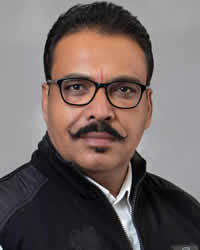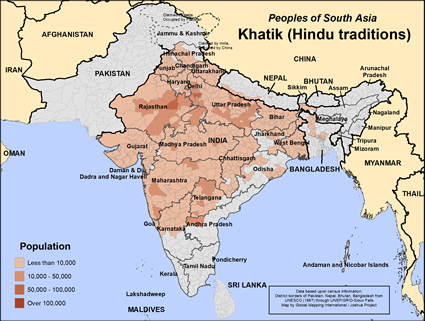Khatik (Hindu traditions) in Pakistan

Photo Source:
Anonymous
|

Map Source:
People Group Location: Omid. Other geography / data: GMI. Map Design: Joshua Project
|
| People Name: | Khatik (Hindu traditions) |
| Country: | Pakistan |
| 10/40 Window: | Yes |
| Population: | 5,100 |
| World Population: | 2,287,100 |
| Primary Language: | Sindhi |
| Primary Religion: | Hinduism |
| Christian Adherents: | 0.52 % |
| Evangelicals: | 0.52 % |
| Scripture: | Complete Bible |
| Ministry Resources: | Yes |
| Jesus Film: | Yes |
| Audio Recordings: | Yes |
| People Cluster: | South Asia Dalit - other |
| Affinity Bloc: | South Asian Peoples |
| Progress Level: |
|
Introduction / History
Khatik word is derived from the Sanskrit language word Khat. Khatik means "butcher." In ancient times the main profession of Khatik caste was to slaughter and prepare sheep and goats. Later their occupation was tanning the skin and selling the hairs of sheep in the market and export the same to western countries to make wigs. They sold the meat of goats to butchers.
In India, there are located mainly in Village — Dujana District-Jhajjar (Haryana State) near Capital of India-New Delhi. In New Delhi, Haryana (Rohtak, Gurgaon, Jhajjar, Bhiwani, Karnal, Ambala) Chandigarh, Jaipur (Rajasthan), Mumbai (Maharashtra), Punjab, Himachal Pradesh, Madhya Pradesh, Maharashtra, Tamil Nadu, Karnataka, Andhra Pradesh, Jammu and Kashmir. A small number live in Pakistan.
What Are Their Lives Like?
Because they once handled carcasses, they are among the lowest in the Hindu social system. Some castes will not eat or drink with them. Today, most are in animal husbandry, agriculture, service industries, and government agencies. Others sell vegetables. Most of the Khatik people are street vendor collecting waste paper, scrap and plastic. There are some doctors, engineers, teachers, lawyers, managers, and administrators among them.
Their marriages are endogamous, eg, between one man and one woman.
Most speak Hindi, but many speak regional languages, often with Hindi as a second language. Because they value education, about half of their populace is literate. Literacy rates are higher among men than among women.
They live in small houses, usually on the outskirts of the villages or towns. Early Khatiks were hard working and honest people.
What Are Their Beliefs?
They are devotees of Goddess Durga, Parvati, Ganesh, Hanuman, Shiv Shankar, Sai, Kabir.
Their cultural and religious history suggests they are open to change. Professional ties can cross religious, clan, and caste barriers. Although the majority are Hindus, some are Sikhs or Muslims. Some converted away from Hinduism to avoid caste discrimination. Whether Hindus, Sikhs or Muslims, their practices are often tinged with animism. Those who decide to follow Christ can be disciplined, ostracized or excommunicated. Few are Christian of any form. For most there are no evangelistic media available.
What Are Their Needs?
They need adequate land, housing, education, and daily food.
Prayer Points
Pray for ministries that meet felt needs, for increased literacy, especially for women.
Pray for Bible distribution and showing the JESUS Film in Khatik communities.
Pray for churches to adopt the Khatiks.
Pray for a caste-wide breakthrough that will bless the Khatiks for eternity.